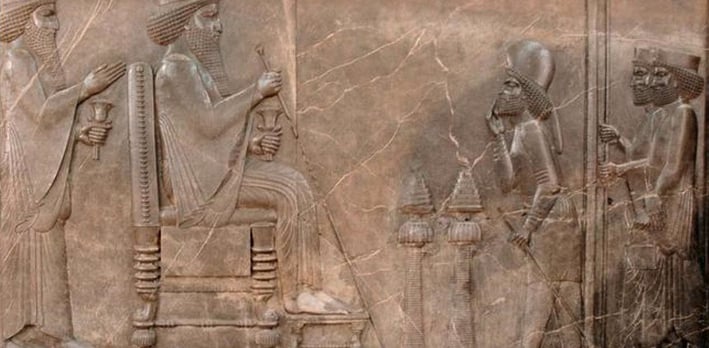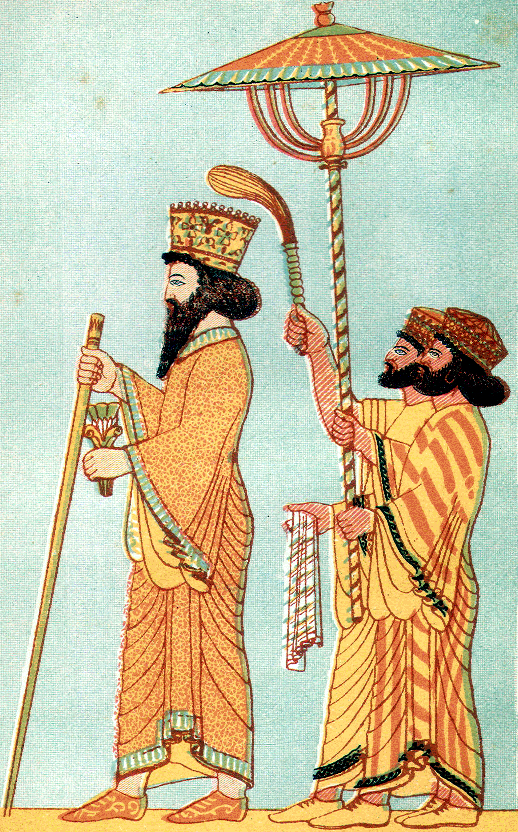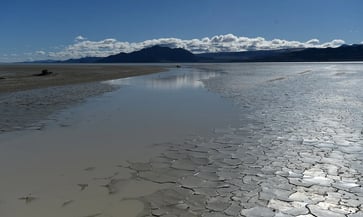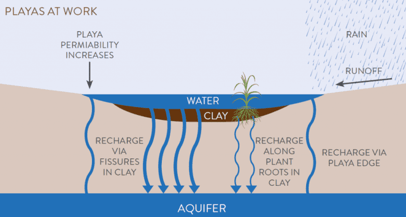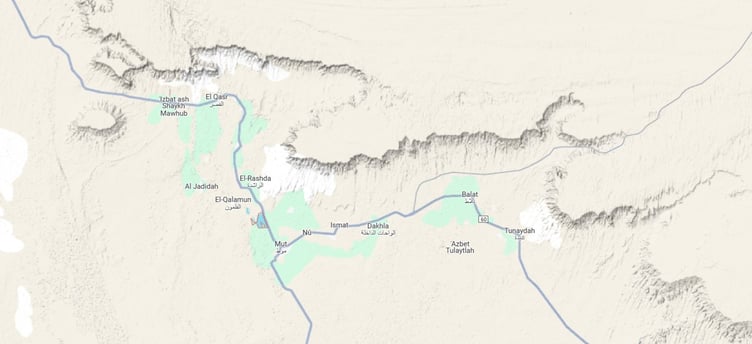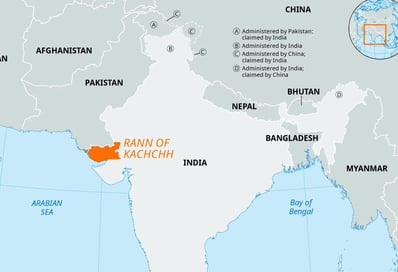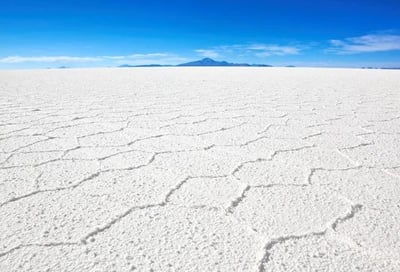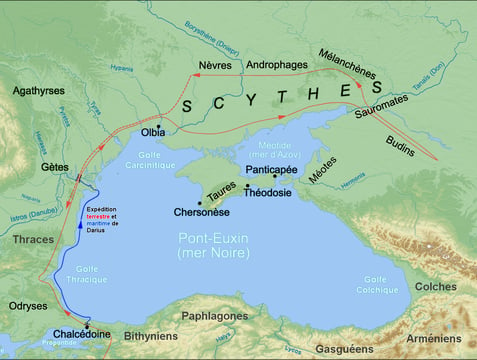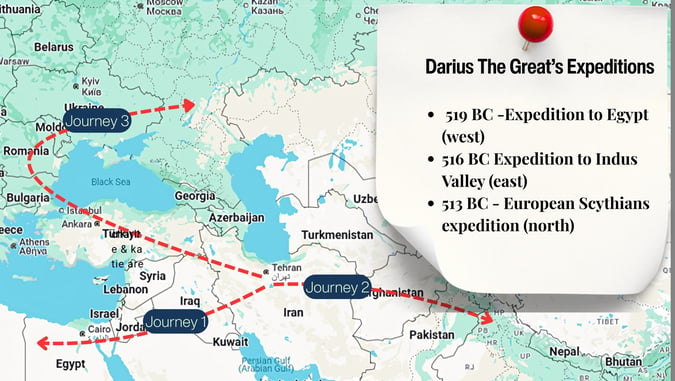For over a thousand years, scholars have debated one of history's greatest mysteries. Who was Dzulqarnain - the righteous king mentioned in the Quran who built a great wall and ruled the largest empire the world had ever seen? Most point to Alexander the Great. But what if they've been wrong all along?
Here, we're diving deep into archaeological evidence, ancient inscriptions, and geographical mysteries that point to a shocking conclusion: the real Dzulqarnain might not be Alexander at all, but rather Darius the Great - the Persian emperor whose empire controlled 44% of the world's population and whose three epic journeys match the Quranic narrative with stunning precision.
Let's start with what the Quran tells us about Dzulqarnain
إِنَّا مَكَّنَّا لَهُۥ فِى ٱلْأَرْضِ وَءَاتَيْنَـٰهُ مِن كُلِّ شَىْءٍۢ سَبَبًۭا ٨٤
Indeed, We established him upon the earth, and We gave him from everything a way [i.e., means].
The word: سَبَب (sabab) used in: وَآتَيْنَاهُ مِن كُلِّ شَيْءٍ سَبَبًا (and provided for him a way to everything - 84) is employed in the Arabic lexicon to denote everything harnessed to achieve an objective. It includes material instruments and resources as well as knowledge, insight and experience etc. (al-Bahr al-Muhit). As for the expression: مِن كُلِّ شَيْءٍ (to everything), it means all things needed by a ruler to run the state system. The sense of the verse is that Allah Ta` ala had provided for the righteous king Dhul-Qarnain practically everything needed at that time in order that he could maintain his just rule, establish universal peace and extend his area of influence to other countries.
Now, here's where things get interesting. When we look at history, one empire stands out as truly unprecedented in scope and administrative sophistication: the Achaemenid Persian Empire under Darius the Great.
Darius I (Old Persian: 𐎭𐎠𐎼𐎹𐎺𐎢𐏁 Dārayavaʰuš; c. 550 – 486 BCE), commonly known as Darius the Great, was the third King of Kings of the Achaemenid Empire, reigning from 522 BCE until his death in 486 BCE. He ruled the empire at its territorial peak, when it included much of West Asia, parts of the Balkans (Thrace–Macedonia and Paeonia) and the Caucasus, most of the Black Sea's coastal regions, Central Asia, the Indus Valley in the far east, and portions of North Africa and Northeast Africa including Egypt (Mudrâya), eastern Libya, and coastal Sudan.
When Darius became king in 522 BCE, the Persian empire was in great turmoil. It had been founded less than thirty years before by Cyrus the Great, who had defeated his Median overlord Astyages in 550 and had taken over his empire. His son Cambyses had succeeded him. He had continued his father's policy of adding new countries to the empire, and conquered Egypt in 525. According to Greek sources like the Histories of Herodotus of Halicarnassus, this king had lost his mind when he heard that his brother Smerdis, whom he believed to be dead, had revolted in 522. Cambyses wanted to rush back to Persia, but when he jumped into the saddle of his horse, the cap fell off the sheath of his sword, exposing the blade, which pierced his thigh. Cambyses died in Syria, without children, leaving the army without commander and the empire to Smerdis - or someone who resembled him.
Darius did not inherit the throne of Persia, but rather came to it through a great deal of political intrigue. The previous occupant of the throne was a usurper, who had assumed the throne by declaring himself Smerdis, the second son of Cyrus the Great. The real Smerdis was dead, having been killed by Cambyses, his older brother, who feared his influence. The imposter stayed almost entirely within the palace and would not see visitors, allowing all of his business to be handled by a trusted minister. A group of seven Persian nobles, of whom Darius was one, became suspicious and hatched a plot to expose the imposter. When the imposter was deposed, the seven briefly considered an oligarchical form of government, but decided instead to select one of their number as the new king, and grant permanent privileges to the other six. Darius, by craft, won the throne of Persia and to seal his position, married Atossa, the daughter of Cyrus the Great. The names of the other six conspirators were Otanes, Hydarnes, Megabyzes, Intaphrenes, Gobryas, and Anspathines. Most played important roles in the administration of Darius and his successors for years to come.
Soon after seizing the throne, Darius faced rebellions throughout the empire . From the onset of his rule as King of Persia in 522 BCE, Darius faced uprisings and instability in all corners of his new empire. Many of these rebellions were crushed by Darius’ lieutenants. The more serious insurrections in Babylon and Media, Darius dealt with personally.
Our knowledge of this critical period in Darius’ reign is benefited by the existence of the Behistun Inscription found on a mountain face in Iran. On the relief Darius himself outlines the course of events. According to the inscription, Darius’ armies fought 19 battles and captured nine kings in the first year of his rule. (Behistun, 4.52.)
Darius I, also known as Darius the Great, crushed all the rebellions that tried to destabilize the empire and solidified control of the territories of the Achaemenid Empire, beginning what would be a historic consolidation of lands.
At its height, the Achaemenid Empire ruled over 44% of the world’s population, the highest figure for any empire in history.
Darius the Great ruled the Persian Plateau and all of the territories formerly held by the Assyrian Empire, including Mesopotamia, the Levant, and Cyprus. It eventually came to control Egypt, as well. This expansion continued even further afield with Anatolia and the Armenian Plateau, much of the Southern Caucasus, Macedonia, parts of Greece and Thrace, Central Asia as far as the Aral Sea, the Oxus and Jaxartes areas, the Hindu Kush and the western Indus basin, and parts of northern Arabia and northern Libya.
This unprecedented area of control under a single ruler stretched from the Indus Valley in the east to Thrace and Macedon on the northeastern border of Greece. At its height, the Achaemenid Empire ruled over 44% of the world’s population, the highest such figure for any empire in history .
During the first year of Darius' reign, he participated in 19 battles and subdued 9 kings that rebelled against him
Darius stabilized and consolidated the empire to become the largest empire at that time to the known world
Darius' Empire size even surpassed those of Alexander the Great and Cyrus
The Achaemenid Empire reached its zenith during the reign of Darius the Great and it truly fit the Quranic description
" Indeed, We established him upon the earth, and We gave him from everything a way [i.e., means]."
Dhul-Qarnayn's journey to the "land of the setting sun" vs Darius' Journey
(So he followed a way.) Ibn `Abbas said that he followed different routes to achieve what he wanted. The statement in verse 86: حَتَّىٰ إِذَا بَلَغَ مَغْرِبَ الشَّمْسِ (until when he reached where the sun sets) means that he reached the far limit towards the West beyond which there was no populated area.
The word: حَمِئَةٍ (Hami'ah) in the succeeding phrase: فِي عَيْنٍ حَمِئَةٍ (into a miry spring) literally means dark marsh or mud carrying the sense of water beneath which there is dark mud and which causes the water it-self to appear black. As for the sense of his seeing the Sun setting into such a spring, it means that an onlooker perceived it as setting into the spring because there was no habitation or dry land in sight. This is like being in an open field while the Sun is setting where as far as one can see there appears to be no mountain, tree, or structure, naturally one who looks at the sight would feel that the Sun was sinking into the land mass.
Dhul-Qarnayn’s Westward Journey: A Mission of Purpose and Justice
The Qur’an presents Dhul-Qarnayn not as a passive traveler, but as a leader with power, resources, and divine sanction. His journey "to the setting of the sun" (Surah Al-Kahf, 18:86) is loaded with strategic and judicial implications. The Qur'anic narrative makes it clear: this was not a voyage of exploration, but of intervention.
“Then he followed a way, until when he reached the setting of the sun, he found it setting in a murky spring, and near it he found a people. We said, ‘O Dzulqarnain, either punish them or treat them with kindness.’” (18:85-86)
Key Clues from the Verse:
“He followed a way” – Sababa in Arabic implies following a course of action, a deliberate path or mission.
“He found a people” – indicates this destination was inhabited, likely of strategic or political concern.
“We said… either punish or show kindness” – signals a moment of moral and legal judgment, as if Dzulqarnain had arrived to assess, arbitrate, or subdue.
The divine permission to “punish or treat kindly” implies that Dzulqarnain had been granted moral authority to exercise justice—a trait reserved for divinely guided kings, not ordinary conquerors.
If the people are rebellious or unjust, he has the right to punish.
If they are righteous or merely ignorant, he may choose mercy.
Dzulqarnain’s travel to the land of the setting sun was an intended intervention, not an incidental detour. The Qur’an paints him as a divinely authorized agent of moral order, likely acting to suppress rebellion, judge a people, and establish justice.
Line 21 of Behistun Inscription : King Darius says: While I was in Babylon, these lands revolted from me: Persia, Elam, Media, Assyria, Egypt, Parthia, Margiana, Sattagydia, and the Saka.
The Behistun Inscription describes how, during the time Darius stayed in Babylon in December 522 BC , a series of of revolts broke out against him, including in Egypt. Subsequently Darius fought a series of battles and to crushed the rebellions and killed the "liar-kings". Only after he put down all the rebellions that he travelled to Egypt to deal with rebellion there. He travelled to Egypt in 519 BC. The Behistun Inscription tells us that Egypt rebelled at the turn of 522/521 BC.
Petubastis IV, also referred to as Petubastis III by some scholars, emerged as a potential rebel-king during a period of significant political upheaval following the death of Cambyses II in March 522 BC. This period, known as the Behistun crisis, saw Bardiya’s usurpation of the Persian throne, creating a power vacuum that native Egyptian leaders exploited. Petubastis IV is generally accepted as a historical figure, with only a few scholars disputing his existence, based on artifacts re-dated by Jean Yoyotte to the late sixth century BC.
The revolt was likely triggered by oppressive taxation and cruelties imposed by the Persian satrap Aryandes, as noted by the 2nd-century Greek author Polyaenus (Stratagems VII, 11 §7). Petubastis IV’s actions capitalized on this discontent, positioning him as a legitimate Egyptian ruler against foreign domination.
Archaeological Evidence and Recent Findings
https://isaw.nyu.edu/news/amheida-excavations-find-new-evidence-on-cambyses-army
Recent excavations, particularly in the Dakhla Oasis at Amheida, have provided crucial evidence for Petubastis IV’s reign. Olaf E. Kaper’s 2015 chapter, “Petubastis IV in the Dakhla Oasis: New Evidence about an Early Rebellion against Persian Rule and Its Suppression in Political Memory”, details the discovery of four complete relief blocks and a fragment from a temple gateway. These artifacts bear Petubastis IV’s full titulary, including previously unknown Horus and Two-Ladies names, indicating a temple dedicated to Thoth. The presence of oil libation remains suggests the temple was functional for several years, supporting a reign of at least two to three years.
So in 519 BCE, Darius launched his westward expedition. This wasn't a casual military campaign - this was a mission of justice. He was traveling to judge a rebellious people, exactly as the Quran describes:
قَالَ أَمَّا مَن ظَلَمَ فَسَوْفَ نُعَذِّبُهُۥ ثُمَّ يُرَدُّ إِلَىٰ رَبِّهِۦ فَيُعَذِّبُهُۥ عَذَابًۭا نُّكْرًۭا ٨٧
He responded, “Whoever does wrong will be punished by us, then will be returned to their Lord, Who will punish them with a horrible torment.
وَأَمَّا مَنْ ءَامَنَ وَعَمِلَ صَـٰلِحًۭا فَلَهُۥ جَزَآءً ٱلْحُسْنَىٰ ۖ وَسَنَقُولُ لَهُۥ مِنْ أَمْرِنَا يُسْرًۭا ٨٨
As for those who believe and do good, they will have the finest reward, and we will assign them easy commands.”
Now here's where modern archaeology gets exciting. Recent excavations at Amheida in Egypt's Dakhla Oasis have uncovered something remarkable: temple blocks with Petubastis IV's full royal titulary - proof that he established a functioning government there for several years before Darius crushed his rebellion.
Recent excavations at Amheida in the Dakhla Oasis have suggested that Petubastis IV may have had his royal residence there. regions.
But the real revelation is geographical. The Dakhla Oasis sits in a geological depression in Egypt's Western Desert. And in this environment, you find something called playa lakes - temporary, shallow lakes that form during rains and then partially dry out, leaving dark, muddy sediment.
The Dakhla Depression in Egypt's Western Desert features several significant playa lakes .
During Darius expedition to deal with rebellion lead by Petubastic IV near the Dakhla Oasis, he must have encountered this playa lake . Semi-dry playa lakes, when water evaporates or drain, the lakebed can turn into a mud flat. This is the "spring murky water" that Darius encounter during his journey to the sun setting land.
Picture this: Darius and his army arrive at the Dakhla Oasis in the evening. Behind them rises the high plateau of the Western Desert. In front of them lies this dark, murky lake. As the sun sets in the west, from their perspective, it would literally appear to be setting INTO this murky water - exactly as the Quran describes.
“Then he followed a way, until when he reached the setting of the sun, he found it setting in a murky spring, and near it he found a people. We said, ‘O Dzulqarnain, either punish them or treat them with kindness.’” (18:85-86)
And his response to the rebellious Egyptians? The Quran records Dzulqarnain saying: "Whoever does wrong will be punished by us, then will be returned to their Lord, Who will punish them with a horrible torment. As for those who believe and do good, they will have the finest reward."
This is exactly what Darius did. He executed the rebel leaders but showed mercy to the common people. He didn't destroy Egypt - he integrated it into his empire with respect for local customs and religion. Justice tempered with mercy - the mark of a truly righteous ruler.
The timeline matches. The geography matches. The moral response matches. This isn't coincidence - this is historical precision.
حَتَّىٰٓ إِذَا بَلَغَ مَطْلِعَ ٱلشَّمْسِ وَجَدَهَا تَطْلُعُ عَلَىٰ قَوْمٍۢ لَّمْ نَجْعَل لَّهُم مِّن دُونِهَا سِتْرًۭا ٩٠
Until he reached the rising ˹point˺ of the sun. He found it rising on a people for whom We had provided no shelter from it.
After crushing the Egyptian rebellion in 518 BCE, Darius turned his attention eastward. Historical records show that around 516 BCE, he launched a major campaign to conquer the Indus Valley - modern-day Pakistan and northwest India.
This was no small undertaking. Darius personally led this expedition, marching his armies across Afghanistan, through the Hindu Kush mountains, and down into the Indus Valley. His goal: to extend Persian control to the very edges of the known world.
The campaign was successful. Darius conquered vast territories from Gandhara down to the southern Indus Valley, reaching areas near modern Karachi. He established the satrapies of Gandara and Hindush - making the Persian Empire truly transcontinental.
This campaign aligned with the Quranic narrative of Dzulqarnain's journey to the " Land of the Rising Sun" . This journey was after Darius subdued the rebellions in Egypt in 518 BC
Journey to the West : 519/518 BC - Subjugation of rebels in Egypt
Journey to the East : 516 BC - The conquest of Indus Valley
The location of the land where he witnessed the sun rising on people who had no protection from its heat.
But here's the geographical revelation that is really interesting. In this region lies one of the most extreme environments on Earth: the Rann of Kachchh. It's a massive salt marsh desert spanning 30,000 square kilometers between India and Pakistan.
The Rann of Kachchh is a salt marshy land in the Thar Desert in the Kachchh district of western Gujarat. It lies between Gujarat in India and the Sindh province in Pakistan. It comprises of around 30,000 sq. km of land which includes The Great Rann of Kachchh, The Little Rann of Kachchh and Banni grassland.
The Rann of Kachchh is famous for its white salty desert sand and is reputed to be the largest salt desert in the world.‘Rann’ means desert in Hindi which in turn is derived from the Sanskrit word ‘Irina’ which also means desert. The inhabitants of Kachchh are called Kachchhi and have a language of their own with the same name.
And here's what's fascinating - the Rann of Kachchh has the same geological origin as the murky spring Darius encountered in Egypt. Both are the result of water evaporation leaving sediment behind. But while the Egyptian playa lake left dark, muddy sediment, the Rann left brilliant white salt crystals.
And the people that he encountered there were the peaceful people , in contrast with the rebellious people in Egypt. It seems that both ends of his journey represent the opposite end of the spectrum.
The people Darius encountered here - the Kachchhi people - had developed unique adaptations to this harsh environment. They had their own language, their own survival techniques, but as the Quran notes, they had "no shelter" from the sun's brutal heat. The description is geographically and climatically perfect.
Look at the sequence: First, Darius travels west to Egypt in 519-518 BCE to deal with rebellion near dark, murky water. Then he travels east to the Indus Valley in 516 BCE, reaching people in a sun-blasted landscape with no natural protection. The Quranic narrative and historical timeline align perfectly.
This level of geographical and chronological precision isn't myth-making - it's historical reporting.
Interesting facts :
West : dark - absorb more light (setting of the sun) , rebellious people
East : white - reflect more light (rising of the sun) , peaceful people
And also the word " spring of water" is really the actual representation of the playa lake at the Dakhla Depression .
"The Dakhla Depression, located in the Western Desert of Egypt, is a structurally-oriented depression that relies heavily on groundwater for water resources. Playas, or desert basins, within the depression have historically held paleolakes and are now characterized by playa deposits. The primary source of water is the Nubian Sandstone aquifer"
The symbolism and the choice of words of the Quran is really a miracle !
ثُمَّ أَتْبَعَ سَبَبًا ٩٢
حَتَّىٰٓ إِذَا بَلَغَ بَيْنَ ٱلسَّدَّيْنِ وَجَدَ مِن دُونِهِمَا قَوْمًۭا لَّا يَكَادُونَ يَفْقَهُونَ قَوْلًۭا ٩٣
Then he travelled a ˹third˺ course
until he reached ˹a pass˺ between two mountains. He found in front of them a people who could hardly understand ˹his˺ language.
قَالُوا۟ يَـٰذَا ٱلْقَرْنَيْنِ إِنَّ يَأْجُوجَ وَمَأْجُوجَ مُفْسِدُونَ فِى ٱلْأَرْضِ فَهَلْ نَجْعَلُ لَكَ خَرْجًا عَلَىٰٓ أَن تَجْعَلَ بَيْنَنَا وَبَيْنَهُمْ سَدًّۭا ٩٤
They pleaded, “O Dzulqarnain! Surely Gog and Magog are spreading corruption throughout the land. Should we pay you tribute, provided that you build a wall between us and them?”
قَالَ مَا مَكَّنِّى فِيهِ رَبِّى خَيْرٌۭ فَأَعِينُونِى بِقُوَّةٍ أَجْعَلْ بَيْنَكُمْ وَبَيْنَهُمْ رَدْمًا ٩٥
He responded, “What my Lord has provided for me is far better. But assist me with resources, and I will build a barrier between you and them.
Darius the Great, launched a military expedition into European Scythia in 513 BC. This campaign aimed to assert Persian dominance over the Scythian lands and potentially disrupt their trade routes . Darius the Great led a large army into European Scythia, an area encompassing parts of modern-day Balkans, Ukraine, and southern Russia. The Scythians were an East Iranian-speaking people who had invaded Media, revolted against Darius and threatened to disrupt trade between Central Asia and the shores of the Black Sea as they lived between the Danube and Don Rivers and the Black Sea
Darius' European Scythian expedition was not a mission of conquest . The objective of the expedition was to drive out the Scythian from the Achaemenid Empire borders.
The people that he met during the the expedition, might lived far away from his empire . Outside the realm of his kingdom. So, it was possible that that they "could hardly understand his language" . They were not primitive people, since they had the knowledge of iron smelting. The advance technology at that time. Even though Darius' army comprised of multi-nationals people, but since the the people they met lived far outside their empire's territories, they were also unable to act as translator. An example of people that lived in the region , were the Finno-Ugric people in Volga Kama region. Their language might sound "foreign" and unitelligible to Darius and his multi-nationals army.
In the Quran, Dzulqarnaian refused to accept the tribute that been offered by the people .
Think about the ethics here. These people lived outside Dzulqarnain's empire. They weren't his subjects, they weren't under his protection or administration. Taking tribute from them would have been exploitation - taxation without representation, as it were.
His answer that, “What my Lord has provided for me is far better" , means that the kingdom that bestowed upon him by Allah swt , is enough for him.
This aligns with the context of Darius expedition. The people that he met , during this expedition were living outside of his kingdom territories . They were not under his protection, or within his administration.
His expedition was not a conquest mission, therefore the "peoples' territories would not be added to his kingdom
Therefore it was not morally right to accept any form of tribute
While the exact location of the "barrier" mentioned in the Quran remains a subject for future research, the context, timeline, and moral framework all align perfectly with Darius's Scythian expedition.
There are other details in Darius life and achievement that are aligned with the phraseوَآتَيْنَاهُ مِن كُلِّ شَيْءٍ سَبَبًا
Darius's historical record demonstrates unprecedented administrative innovation.
Darius the Great was considered as one of the greatest administrator of his time
Perhaps most significantly, Darius achieved what the Quranic Dzulqarnain represents: universal sovereignty exercised under divine authority. His empire was literally the largest the world had ever seen, encompassing roughly 44% of the world's population at its peak, yet administered with remarkable justice and religious tolerance."
Now, here's what makes this identification even more compelling. Many of the historical details that support Darius as Dzulqarnain weren't known until very recent archaeological discoveries.
The full extent of Darius's empire wasn't mapped until the 19th and 20th centuries. The sophistication of his administrative system wasn't understood until cuneiform tablets were deciphered. The details of his religious beliefs weren't clear until his inscriptions were translated. The precise nature of his campaigns wasn't known until modern historical research.
For centuries, the identification of Dzulqarnain was dominated by Alexander the Great. This association was so strong that any historical figure who didn't fit the Alexander mold - warrior-king, empire founder, mighty conqueror - was immediately dismissed.
But here's the problem: Alexander doesn't actually fit the Quranic description very well. His empire, while impressive, was short-lived and collapsed immediately after his death. He didn't establish lasting administrative systems. His journeys don't match the geographical descriptions. And morally, Alexander was known for his excessive drinking and increasingly erratic behavior - hardly the model of righteous leadership.
Darius, on the other hand, was the opposite: a builder rather than just a destroyer, an administrator rather than just a conqueror, a just ruler rather than a despot. His empire lasted for centuries. His administrative innovations influenced governance for millennia. His moral code, based on "Good Thoughts, Good Words, Good Deeds," aligns perfectly with Quranic values.
And now, modern archaeology is vindicating this identification. The discovery of Petubastis IV's temple at Amheida confirms the Egyptian rebellion and its suppression. Persian administrative tablets found across the empire show the sophistication of Darius's government.
The Behistun Inscription itself - Darius's own account of his early battles - reads like a historical commentary on the Quranic narrative. He explicitly credits divine assistance for his victories and emphasizes his role as an agent of cosmic justice.
This isn't cherry-picking evidence to fit a theory - this is allowing the evidence to lead us to a conclusion that scholars of previous generations simply didn't have enough information to reach.
So what makes Darius such a compelling candidate for Dzulqarnain? It's not just the geographical matches or the chronological alignment - it's the character profile.
The Quran emphasizes that Dzulqarnain was given "from everything a way" - comprehensive means to rule justly. Darius's administrative innovations were revolutionary: the first international postal system, standardized weights and measures, a consistent legal code, religious tolerance, and infrastructure projects that connected three continents.
His engineering achievements were legendary: a precursor to the Suez Canal connecting the Nile to the Red Sea, the Royal Road spanning 1,600 miles with rest stations every 15 miles, Persepolis - one of the ancient world's architectural marvels, and extensive fortification systems protecting the empire's borders.
And the lasting impact? Darius's empire provided stability and prosperity for millions of people across three continents for over two centuries. His vision of universal governance under divine authority became a template for righteous rule.
This is what "from everything a way" looks like in practice - not just the means to conquer, but the wisdom to govern justly and the moral authority to protect the innocent across the known world.
So there you have it - three epic journeys that align with stunning precision between the Quranic account and the historical record of Darius the Great. The westward journey to judge rebels at the murky spring of Dakhla Oasis. The eastward expedition to the sun-scorched salt marshes of the Rann of Kachchh. The northern campaign to help foreign peoples against raiders while refusing their tribute.
DARIUS THE GREAT, THE REAL DZULQARNAIN, THE TRUE POSSESSOR OF TWO HORNS

